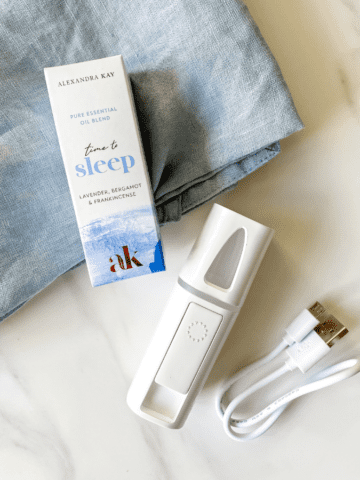When it comes to migraine there isn't a 'one-size-fits-all' set of symptoms, so getting a diagnosis can be a struggle. Head pain, light and sound sensitivity and nausea are some of the more common symptoms, but when it comes to slightly more rare types such as vestibular migraine you may not experience head pain at all. No wonder some of us see many doctors before we receive an accurate diagnosis.
The next steps after a migraine diagnosis can really transform our health and wellbeing. Sometimes though, it can feel as though medication is the only option and perhaps your doctor doesn't look too far beyond that. I hope the tips below offer some topics to discuss with your doctor or medical team to improve living with migraine.

Jump to:
1. See a specialist headache / migraine doctor
All too often people with suspected migraine are either only treated by their primary care doctor, or referred to a general neurologist. This was definitely my experience. I battled with my primary care doctor for months with him suggesting my symptoms were anxiety when I knew they were not. Part of the 'battle' was that, at that time, I was actually having migraine without headache. And my GP wasn't aware that this was possible.
Then I finally got a referral to a neurologist who told me I had vestibular migraine, handed me a generic set of physiotherapy exercises and discharged me. Yes, on my first and only appointment!
My next move was to do a lot of research on specialist doctors for vestibular migraine. I eventually found a leading specialist who transformed my care. As well as running tests to rule out other conditions, she referred me to another specialist headache doctor as I had started to experience head pain too and referred me to a physiotherapist.
So, I would suggest making sure that you are seeing the right doctor. It sounds basic, but is so important. They should have experience of treating migraine and have that as their speciality. Those doctors will have the best knowledge on treatment plans and the new treatment options for migraine, and for your form of migraine in particular.
2. Track your symptoms and migraine attacks
Most headache clinics ask their patients to track their symptoms and pain level (as well as other symptoms such as nausea and dizziness) so they can assess fluctuations and see how different medications and treatments work for you.
Some clinics provide symptom tracker forms, but if yours doesn't then you may like to try something like the Headache Tracking Journal. It has lots of sections for your medications / supplements, food and hydration sleep and activity levels, amongst other areas. Perfect for having all your info in one place!
3. Read up on migraine
Personally I would resist doing a ton of googling for 'cures' and stick to information on managing migraine from reputable sources that are approved by doctors. There is so much information out there that is plain odd or suspect. I read recently that putting cinnamon on your forehead would cure you . . .
One of the best online resources is the Migraine Trust, which has so much information on everything from medication to exercise to lifestyle measures. For vestibular migraine, the Vestibular Disorders Association (VeDA) is brilliant and I refer to it over and over again.
In terms of books, there are many great ones out there but many are a little out-dated given the new advances with medications and injectibles in recent years. Some that I like, and are good just after a diagnosis, are:
The Migraine Brain, Carolyn Bernstein
50 things you can do today to manage migraines, Wendy Green
Heal your Headache, David Buchholz
Victory over Vestibular Migraine, Shin Beh

4. Physiotherapy / physical therapy
Seeing a physiotherapist / physical therapist can be useful in two different ways depending on the type of migraine you experience, and your personal circumstances. It is definitely worth asking your doctor for their thoughts on this.
Vestibular rehabilitation therapy (VRT)
This form of therapy can help those with vestibular migraine. It should be undertaken with a therapist who specialises in VRT. If you get given a generic set of exercises as I did, then I would consider seeing a different therapist. It should be tailored to your specific symptoms and needs, and be carefully paced to you as an individual.
Physiotherapist / physical therapist
I haven't heard too much about those living with migraine seeing a physiotherapist, and I do think it is under-rated as an approach. Regular moderate exercise has been found to be an effective way to reduce the frequency of attacks for some people.
Trouble is, when you have chronic migraine exercise may feel very daunting or trigger an attack. As the Migraine Trust sets out in a really good overview of exercise, there are certain ways to approach exercise that may help you if you wish to pursue it.
I found that seeing a physiotherapist was really beneficial in guiding me. We discussed all my symptoms, including those from POTS / dysautonomia, and worked out an exercise plan that would best suit me. I started by using a pedal exerciser as that didn't involve head movements, and then gradually built up to walking and other forms of exercise. I would really recommend a session or two to help you in the beginning.
5. Exercise
As already mentioned, exercise has been shown to reduce the frequency of attacks for some people. Having a chat with your doctor before you start a new exercise program is always recommended and they may suggest seeing a physiotherapist / physical therapist to help you out.
6. Occupational therapy / health
Another suggestion that I haven't seen mentioned too often. Occupational therapists can be so helpful in your next steps after a migraine diagnosis if your symptoms are making certain tasks or activities a challenge to complete. They can help with activities at home or work, or in an educational setting.
7. Helpful products
I think most of us with migraine end up with our own 'migraine kit' of helpful products to help us manage symptoms. All these are non-drug options that hopefully will help reduce pain and other symptoms.
Headache hat - a wearable 'hat' that has engineered ice to help you target that 'hot head' feeling.
Koldtec ice towel - also with engineered ice, you wrap around your head (and I use mine for my cranky knee too!).
4 head stick - my first migraine product(!) and very affordable. It uses menthol to help block pain signals to the brain.
Migraine shield glasses - stylish glasses with blue light blocking technology that can help prevent migraine attacks.
- You can get 20% off migraine shields with the code throughthefibro (affiliate code)
Blisslets nausea relief bands - amazing as a non-drug treatment for nausea (and they are so pretty nobody will know they are for a medical reason!)
- Blisslets has kindly given me a code so that my readers can get 15% off with the code fibrofog (affiliate code)
8. Supplements
There are several supplements that are backed by research for use in helping to manage migraine, but always (always, always!!) check with your doctor before trying something new as it may contra-indicate with other medications you are on or not be advisable with other medical conditions.
The three main supplements are:
9. Calming activities
Perhaps this is also an obvious, but it's also so important! I am lucky to have a doctor and medical team that talks a bit about restful and relaxing activities, but I know many doctors aren't so great on this.
Some ideas include meditation, gentle yoga, crafts, listening to audio books (maybe not horror or thrillers though!), light gardening, journalling and being in nature.
There are some more suggestions in my book Living well with Fibromyalgia, which has lots of ideas for helping to manage all chronic illness conditions and not just migraine.
I hope these next steps after a migraine diagnosis are helpful. Always remember that you are an individual with migraine and treatment options should be geared towards your specific symptoms, form of migraine and any other medical conditions.
I'm active on Instagram, Facebook and Twitter if you would like to follow along for more posts on living with migraine!
Related posts:
5 positive aspects of Botox for chronic migraine
Don't forget to pin the post!

Please follow the advice of your doctor as to all medical treatments, supplements and dietary choices, as set out in my disclaimer. I am not a medical professional, and this post, as well as all other posts on this blog, are for informational purposes only.

















Sheryl says
Great tips, I love that you included various therapists and doctors who may be able to help, and not just 'one doctor'. I hope your vestibular migraine gets better, and this is a useful post for those who are trying to narrow their what sort of migraine they have.
throughthefibrofog says
Thanks Sheryl, I think a lot of people only get to see a doctor but other health professionals can be so helpful to managing migraine too.
Caroline says
I have had migraines for years, and had never heard of nausea bands!! I was so excited to read that these exist as nausea is one of my WORST migraine symptoms. I am going to try them out ASAP (: Great post!
throughthefibrofog says
Oh you need to get some bands!!! They are so good for helping my nausea and I love that these ones don't look 'medical' at all. Hope they help you too!
Shruti Chopra says
Brilliant that you kept at it, looking for answers when you knew what you're getting wasn't enough and I'm even happier to read that you found a doctor who has been so helpful. We really need good doctors to guide us.
throughthefibrofog says
It's always such a relief to find a great doctor isn't it. Really transforms our care, and our confidence in managing our health.
Chronic Mom says
It never occurred to me to go to a physical therapist back when I had migraines. Great suggesion!
throughthefibrofog says
I found it so helpful, especially to get back into exercise which was so beneficial in the long-term!
Cherry | It’s All Cherry says
I used to suffer from terrible migraines especially when I was pregnant. I kept track of my triggers and took medications as soon as I felt them coming. I’m glad this worked for me. I can’t imagine needing more medical care than that.
throughthefibrofog says
I'm glad you were able to identify your triggers, and were able to halt attacks. With chronic migraine, likely due to my other conditions, it's not possible for me to do that effectively unfortunately.